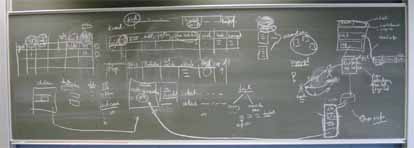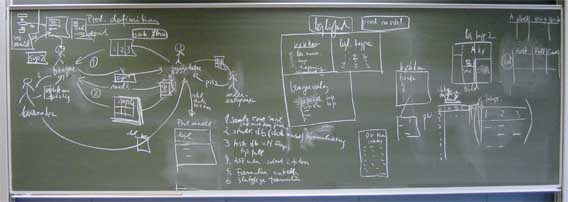
Mini-project/Exercises

|
Virtual Building, sem7 2000 Mini-project/Exercises |
| [home] [education] [semester 7] | Last update 2000.11.23 (2000.11.15) [2000.10.03] |
Mini-project/Exercises.
|
The students come from semester 6 of the civil engineering program. (You can also take a look at the exercice sem7 1999 notes). The course exercises will form part of a mini-project on e.g. how to efficiently collect and make experiences re-usable from the semester 7 building site project. A major problem today is to efficiently use experiences gathered during a project. Knowledge is stored in persons heads and re-used as these persons are involved in new projects. IT gives us opportunities to create meta knowledge (knowledge about knowledge, who knows what about what?) and also make computer stored knowledge easier accessible. We see everyday examples on mistakes and faults which could have been avoided especially if you are given some hints about where we problems could be expected.
During the NN building project the group
will capture problems and their solutions. This information shall
be captured
and stored by means of IT support. A similar project, SERFIN, regarding
handling of technical building maintenance information is found at
http://it.civil.auc.dk/it/reports/r_serfin2_5_1999.doc. See also the knowledge acquisiton and quality marking process at
serfin_process
We could call the mini-project MEXIN2000, management experience on Internet. MEXIN2000 should be available from an optional website through a conventional HTML browser. The following activites will contribute to the buiding-up of MEXIN2000
|
Introduction to ASP (Active Server Pages) for WWW-database connectivitiy.
Group discussion 4010a, 15.11.2000The mini project is done in collaboration with Spännkom in Aalborg. The idea is to rationalize the form fill out of faults reported and to collect these in a database for future knowledge management within the company.The group presents a conceptual layout of a form for accessing data stored in a database. The form is the starting point for a discussion and modeling of the underlying data structure. Previous discussions have revealed the group aims at an ASP/HTML access database implementation. Work flow, sequence models, and use cases has been described before The Customer, C, reports a problem to a Case Handler, CH. CH discusses the problem withh C and fills at the same time in a form. The form should be handled from the web client and information stored in a database. The form has the following structure

Click on the image to enlarge The next steps will be
Group discussion 4010a, 15.11.2000In the conceptual modelling phase we choose to put up work models for
http://it.civil.auc.dk/it/education/slides/contextual_design.html http://it.civil.auc.dk/it/education/sem7_2000_vb_it_mngmnt/conceptual_modelling/index.html Work flow model in the group 4010B mini-project involves the following roles.

Click on the image to enlarge B gets alternative layout proposals for a flat from P. B chooses an alternative which goes to P. P transfers information to the Product Model, PRM, dtabase (this case is not treated here.)
B then has the possibilities to choose between alternative modifications (alterations) within the flat, e.g. opening between kitchen and living room.
The communication between Band P is through P's 'digital agent' to ease the burden on P. (This communication will take place on the WWW through forms and DB accesses).
B also negotiates kitchen layout and installations with a Kitchen deliverer (vendor), K.
In the workflow models the 'total' functionality is sketched,but not all is implemented, e.g. it is shown that P negotiate prices with sub contractors). The artefact models in the mini project mainly consists of the web communication interfaces and PRM. The PRM has the following parts
|

|

|

|
|
Per Christiansson |